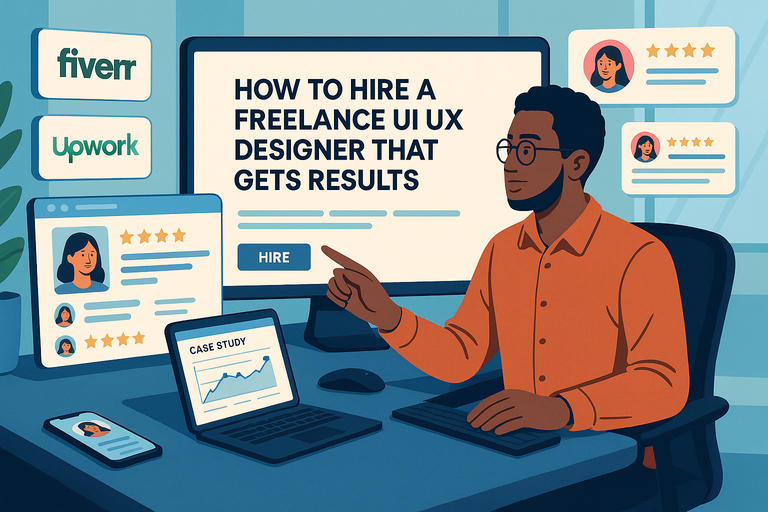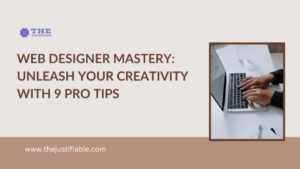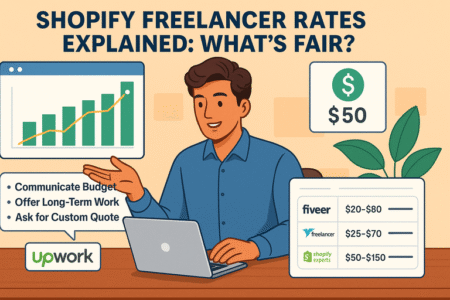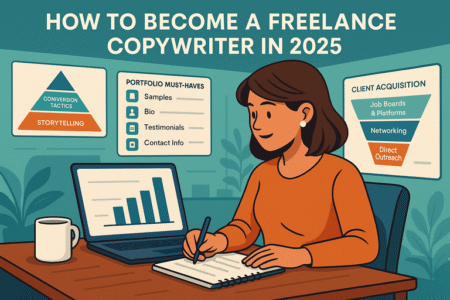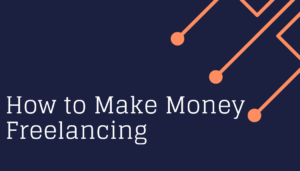Table of Contents
Hiring a freelance UI UX designer can feel like searching for the perfect translator between your product and your audience. You want someone who not only understands how things should look but also how people actually use them.
But how do you know which designer will deliver results instead of just pretty screens?
This guide answers that question step by step, breaking down what to look for, what to ask, and how to make the right choice so your project doesn’t stall on visuals but moves forward with real user-focused design.
Understand What a Freelance UI UX Designer Really Does
Before you hire a freelance UI UX designer, you need to know what they actually bring to the table. Too often, businesses confuse a beautiful design with a functional one, but the truth is, real design goes far beyond colors and layouts.
A designer isn’t just creating screens; they’re building an experience that helps your users feel confident, supported, and eager to return.
Clarify the Difference Between UI and UX
UI stands for User Interface, which is all about the look and feel of your product. Think buttons, typography, colors, and spacing. If you’ve ever landed on a website that felt polished, clean, and professional, that’s strong UI design at work.
UX, on the other hand, means User Experience, which focuses on how someone actually moves through your product or service. It answers questions like: Is the navigation intuitive? Can people easily complete a task, such as checking out on an ecommerce site? Does the flow reduce frustration?
Here’s an easy way to think of it:
- UI is how your product looks.
- UX is how your product works.
If UI is the car’s paint job and dashboard, UX is the engine and how smooth the ride feels. Without one, the other falls flat.
Why Both Skills Matter in a Single Designer
When you hire a freelance UI UX designer, you’re often getting one person who can blend both worlds. This matters because users don’t separate “look” and “function” in their minds. They see the product as a whole.
For example:
- A gorgeous landing page (UI) that takes forever to load or confuses the user (UX) won’t convert.
- A perfectly logical checkout flow (UX) that looks outdated and untrustworthy (UI) won’t inspire confidence.
A designer who can handle both ensures that the aesthetics match the usability. I believe this balance is what creates results, because users judge credibility in seconds but stay loyal based on how smoothly they can achieve their goals.
When to Hire a Specialist Instead of a Generalist
Not every project needs a jack-of-all-trades. Sometimes, it makes sense to hire a specialist.
- If you’re launching a product that’s heavy on workflows or requires user testing (like a SaaS dashboard), a UX specialist will be essential.
- If you already have strong user flows but need branding consistency, motion graphics, or highly visual work, a UI specialist might be the better fit.
- For smaller businesses or startups, I suggest a generalist who can deliver both. But as your company grows, layering specialists on top of a generalist ensures depth without losing cohesion.
The trick is being clear about what your project needs before you post that job listing — which leads us to the next big step.
Define Your Project Goals Before You Search
Jumping straight into hiring without clear goals is like asking someone to build you a house but not knowing whether you want a cabin, a townhouse, or a mansion. A freelance UI UX designer can’t read your mind.
The clearer you are, the better they can deliver designs that align with your business vision.
Identify the Core Problem You Want Solved
Design starts with solving a problem, not just making something pretty.
Ask yourself:
- What’s broken in your current product or website?
- Are users abandoning carts?
- Is your mobile app clunky?
- Do visitors fail to understand what you offer in the first 10 seconds?
By identifying the real issue, you give the designer a target to aim at.
For example, if the core problem is high bounce rates on your homepage, the designer knows to focus on clarity and intuitive navigation rather than just refreshing the color scheme.
Translate Business Objectives Into Design Needs
Here’s where strategy meets creativity. Your business goals should shape the design direction. If your objective is to increase sign-ups, your designer needs to emphasize clear CTAs (calls to action) and reduce friction in the sign-up process.
If your goal is boosting trust, the UI should highlight testimonials, security badges, and clean branding.
Think of it like this:
- Business goal: Increase conversions.
- Design need: Streamlined checkout flow, persuasive button placement, and reassuring microcopy.
This translation is what separates random redesigns from truly impactful design work.
Align Project Scope With User Experience Priorities
Designers thrive when they know what matters most to your users. Scope creep often happens when businesses want everything at once, but the reality is, not all features carry equal weight.
Here’s a practical approach:
- Start by mapping user journeys — what steps do people take from first visit to completed action?
- Identify the “must-haves” versus “nice-to-haves.”
- Scope the project around the essentials first.
For example, if you’re building a learning platform, it’s more critical that students can quickly log in and access lessons (UX) than having fancy animations (UI) at launch.
A clear scope focused on user priorities helps you and your designer stay aligned, saves money, and avoids endless revisions.
Pro insight: The designers who get you results aren’t just artists. They’re problem solvers, strategists, and user advocates. The more clarity you bring to the table, the more they can unlock the full potential of your project.
Know Where to Find Qualified Freelance UI UX Designers
Finding the right freelance UI UX designer isn’t just about scrolling through endless profiles. The trick is knowing where to look and how to filter the noise. Some platforms are flooded with talent, while others feel more like job boards with little vetting.
Let me break down the best places to search and how to spot someone worth your time.
Use Trusted Freelance Marketplaces and Platforms
Marketplaces are often the first stop for businesses hiring freelancers, and for good reason—they’re easy to browse and come with built-in payment protections.
Platforms like Upwork, Fiverr Pro, and Toptal have filters that let you search specifically for UI UX designers. The advantage here is volume. You’ll see dozens of designers in minutes, each with reviews, hourly rates, and work histories.
Here’s a pro tip: Don’t just sort by price. Instead, look for freelancers who explain their process clearly in their profiles. A strong designer will talk about research, user flows, and testing—not just “making websites look good.”
I advise starting with a small pilot project on these platforms, like a single landing page redesign. It gives you a chance to evaluate their workflow without committing to a full app overhaul.
Explore Design Communities and Professional Networks
If marketplaces feel too transactional, design communities are where you’ll find professionals who live and breathe design.
- Dribbble and Behance showcase portfolios with a strong visual focus. They’re fantastic for spotting designers whose aesthetic matches your brand.
- LinkedIn gives you a more professional angle, where you can check a designer’s work history, endorsements, and connections.
The difference with communities is that you’re seeing passion-driven work. On Dribbble, for example, a designer might post a concept app interface that never went live, but it shows you how they think.
Combine this with LinkedIn’s credibility check, and you can quickly spot designers who are both creative and experienced.
I suggest shortlisting two or three designers from these networks and reaching out directly.
A personalized message like “I really liked how you simplified navigation in your XYZ project—would you be open to discussing a similar challenge I’m facing?” gets better responses than generic job postings.
Tap Into Referrals and Industry Recommendations
Nothing beats a trusted referral. If you know founders, marketers, or developers who’ve worked with freelance UI UX designers before, ask them. Good designers often don’t spend their days pitching on platforms—they stay busy through word-of-mouth.
In my experience, referrals usually lead to designers who already have a reputation for being reliable, which saves you time and risk.
The only catch: Demand. Referred designers are often booked out, so be prepared for longer timelines.
If you don’t have a big network, join Slack or Discord groups for startups and design. These communities are goldmines for recommendations because people openly share who’s good and who isn’t.
Evaluate a Designer’s Portfolio With a Critical Eye
Once you’ve found potential candidates, their portfolio becomes your roadmap. But here’s the catch: not all portfolios are created equal. Some are flashy but empty, while others quietly reveal a designer’s problem-solving genius.
Let’s talk about how to read between the pixels.
Look for Case Studies That Show Problem-Solving
A strong freelance UI UX designer won’t just show final screens—they’ll walk you through the problem, their process, and the result. This is the difference between a “pretty picture” portfolio and a strategic one.
A good case study might start with a challenge like: “Users were dropping off during checkout.” Then it explains how the designer researched the issue, tested different flows, and redesigned the process to cut drop-offs by 25%.
That’s the type of thinking you want to see. I believe this shows whether they’re capable of improving your business metrics, not just aesthetics.
Assess Design Consistency Across Different Projects
Consistency tells you a lot about a designer’s discipline. Even if they’ve worked on wildly different industries—say, fintech apps and e-commerce sites—you should notice a clear attention to usability and a coherent design system.
Look closely at:
- Spacing and alignment
- Button styles and CTAs
- Typography choices
If their work feels disjointed from project to project, it could mean they struggle to maintain brand alignment. But if you see a pattern of thoughtful, consistent execution, you know they can adapt their style while still honoring a brand’s identity.
Spot Red Flags in Shallow or Over-Polished Portfolios
Here’s where you need to be cautious. Some portfolios look stunning at first glance but raise concerns the deeper you go.
Watch out for:
- No context or explanations: Just polished mockups with no story.
- Stock-template feel: If everything looks like a copy of a popular UI kit, it suggests they’re not thinking creatively.
- Too much fluff: Overly polished presentations with no real-world examples might indicate inexperience.
A simple test: Ask them to explain one portfolio project in detail. If they can walk you through the problem, their choices, and the outcome without skipping a beat, you’ve found someone who actually does the work—not just someone good at posting pretty screenshots.
Pro tip: When reviewing portfolios, focus less on whether you “like” the design and more on whether it solves problems. Design isn’t art; it’s communication. The best freelance UI UX designers know the difference.
Ask the Right Questions During Interviews
An interview with a freelance UI UX designer isn’t just about checking their resume. It’s your chance to peek into how they think, solve problems, and work with people.
The right questions reveal if someone is not just talented but also a good fit for your project.
Test Their Process for Research and User Testing
A skilled designer doesn’t just start pushing pixels around; they start with research. I suggest asking something like: “How do you learn about users before designing?”
Listen for answers that include:
- User interviews or surveys: Even simple ones show they value real data.
- Analytics tools: For example, using Google Analytics or Hotjar to see where users drop off.
- Prototyping and usability testing: Even if it’s lightweight, they should mention testing ideas before launch.
For instance, if you’re building an ecommerce site, a thoughtful designer might say: “I’d start by mapping the current cart flow, then run a quick test with five users to see where friction happens.” That’s someone thinking like a problem solver, not just an artist.
Learn How They Handle Feedback and Revisions
Design isn’t a one-and-done process. You’ll want someone who sees feedback as collaboration, not criticism.
A good question is: “What’s your process for handling revisions?”
- A strong answer: They’ll talk about clarifying the feedback, grouping it by priority, and providing rationale when they disagree.
- A weak answer: They just “make changes as asked” without pushing back if something hurts usability.
I believe a great designer balances flexibility with expertise. If you suggest adding ten buttons to your homepage, they should gently explain why that’s confusing instead of blindly doing it.
Gauge Communication Skills and Reliability
Designers don’t work in a bubble—they need to communicate clearly with you and possibly your team.
I recommend asking:
- How often do you give updates?
- What tools do you use for collaboration (Slack, Trello, Notion)?
- How do you handle deadlines if something unexpected comes up?
Reliability often comes down to communication. A freelance UI UX designer who says, “I send weekly progress updates and flag roadblocks early” is going to save you a lot of headaches compared to someone who vanishes until delivery day.
Check for Industry Knowledge and Tools Expertise
A polished portfolio is great, but tools and knowledge show how efficiently a designer can bring ideas to life. This section helps you separate someone dabbling in design from someone who lives it.
Assess Familiarity With Design Tools Like Figma and Sketch
These tools are the bread and butter of UI UX design. At a minimum, your designer should know Figma since it’s now the industry standard for collaborative design. Sketch, Adobe XD, and even Canva for lightweight mockups are also common.
Here’s a practical test: Ask them to walk you through how they use components or shared styles in Figma. If they can explain how they keep buttons, colors, and typography consistent across dozens of screens, you’ve got someone who understands scalable design systems.
Look for Understanding of Accessibility Standards
Accessibility isn’t optional anymore—it’s essential. A designer who ignores it risks excluding a large percentage of users (and creating legal headaches in some regions).
You might ask: “How do you make sure designs are accessible?” Strong answers could include:
- Using sufficient color contrast (they might reference WCAG guidelines).
- Designing with screen reader compatibility in mind.
- Ensuring interactive elements are large enough to tap on mobile.
Even small touches like using real text instead of embedding text in images make a big difference for accessibility. I advise never skipping this check when hiring.
Evaluate Their Awareness of Design Trends vs. Best Practices
Trendy design can be fun, but if every site starts looking like the same minimalist template, users get confused. A professional designer should balance trends with timeless usability.
I suggest asking: “How do you balance current design trends with best practices?”
- A good answer: “I’ll incorporate fresh visuals when they improve clarity or engagement, but I rely on proven usability principles for structure.”
- A bad answer: “I like to follow what’s popular on Dribbble.”
From what I’ve seen, the best freelance UI UX designers borrow inspiration from trends but anchor their work in principles like clear navigation, readable typography, and intuitive interactions.
Verify Testimonials, References, and Client Feedback
Portfolios show skill, but feedback shows reliability. Checking references and testimonials is how you confirm whether a designer actually delivers what they promise.
Read Between the Lines in Client Testimonials
Not all glowing reviews are equal. Some say, “Great work, would hire again,” while others tell a story about how the designer improved conversions or met impossible deadlines.
When reading testimonials, I suggest looking for details like:
- Specific outcomes (increased sign-ups, reduced drop-offs).
- Praise for communication and reliability, not just the design itself.
- Repeat clients, which usually means trust and long-term success.
The more specific the testimonial, the more confidence you can have in the designer’s track record.
Ask for Direct References to Confirm Reliability
It’s reasonable to ask a designer for 1–2 references from past clients. A quick 10-minute chat with a previous client can reveal things you’ll never see in a portfolio.
Questions to ask references:
- Did the designer meet deadlines?
- How did they respond to unexpected challenges?
- Would you hire them again?
I’ve found these conversations often surface the real strengths and quirks of a freelancer—the things you only notice once you’re deep into a project.
Check Freelance Platforms for Verified Reviews
If the designer works through platforms like Upwork or Fiverr Pro, use the built-in review systems to your advantage. Verified reviews are harder to fake and often include metrics like job success rate or repeat hires.
But don’t stop at the star rating. Dig into the written reviews. Look for patterns: Are clients consistently praising their problem-solving? Or are there quiet hints about missed deadlines?
This step takes a bit of detective work, but it’s worth it. You’re not just hiring someone for their skills; you’re trusting them with your business goals.
Pro tip: Hiring a freelance UI UX designer is like dating—you’re not just looking for “talent,” you’re looking for someone who communicates well, shows up when needed, and makes you feel confident moving forward.
Understand Pricing Models and Budget Alignment
Before you hire a freelance UI UX designer, you need to get clear on pricing. Rates can range wildly—from $25 an hour on marketplaces to $150+ for seasoned pros—and the structure matters just as much as the number.
Compare Hourly Rates vs. Fixed-Project Pricing
Hourly rates are flexible. You pay for the time spent, which works if you’re not sure about scope or expect a lot of revisions. Fixed-project pricing gives you clarity upfront, but it requires well-defined deliverables.
Here’s what I’ve seen work best:
- Hourly: Good for ongoing work like design tweaks, usability tests, or adding new screens over time.
- Fixed: Better for complete redesigns, app prototypes, or projects with a clear start and finish.
For example, if you need three landing pages redesigned, fixed pricing makes sense. But if you’ll be experimenting with flows and want ongoing iterations, hourly is more realistic.
Learn How to Spot Overpriced or Undervalued Work
Low rates aren’t always a bargain, and high rates aren’t always justified. I suggest looking beyond the number and asking: “What do I actually get for this price?”
Red flags to watch:
- Undervalued work: A designer offering $10/hr might just recycle templates without deep thinking.
- Overpriced work: A designer quoting $5,000 for a one-page design with no research is likely charging for ego, not value.
Instead, judge pricing against case studies. If someone can show how their redesign boosted conversions by 30%, a higher rate is often worth it.
Balance Cost With Long-Term Value
Think of design as an investment, not an expense. The right freelance UI UX designer can save you money down the line by reducing churn, increasing conversions, and avoiding costly redesigns.
I always recommend asking yourself:
- Will this design help me acquire more customers?
- Does it reduce friction and lower support costs?
- Is it flexible enough to scale as my business grows?
When you factor in long-term gains, what looks “expensive” upfront often pays for itself many times over.
Start With a Small Test Project Before Committing
Even the best portfolio doesn’t guarantee a smooth working relationship. That’s why I suggest running a test project before diving into a full-scale redesign. It’s like dating before marriage—you get to see how things feel in practice.
Use Trial Projects to Test Collaboration Fit
A test project doesn’t have to be big. It could be:
- Redesigning one landing page.
- Creating wireframes for a new signup flow.
- Improving the UI for a single mobile screen.
This gives you a low-risk way to see how they approach research, creativity, and delivery.
Evaluate How They Handle Deadlines and Revisions
The test project isn’t just about output—it’s about process. Pay attention to:
- Did they hit deadlines without constant reminders?
- How did they respond to your feedback?
- Did they explain their design choices or just make edits?
If they’re late, unresponsive, or defensive during a small project, imagine the stress on a big one.
Review Final Deliverables Against Your Expectations
At the end, review the deliverables with three lenses:
- Quality: Does it look professional and polished?
- Usability: Does it solve the problem you outlined?
- Clarity: Did they document the design choices so you understand the “why”?
This small step gives you confidence that your chosen freelance UI UX designer can handle the real thing.
Build a Strong Working Relationship After Hiring
Hiring is only the start. The best results come from building a partnership where your designer feels like part of the team, not just a temporary vendor.
Set Clear Communication Guidelines Early On
I believe clear communication upfront saves 90% of problems later. Decide on:
- What tools you’ll use (Slack, email, Asana).
- How often you’ll check in (weekly, bi-weekly).
- What updates you expect (progress reports, milestones).
It keeps everyone on the same page and avoids the dreaded “radio silence.”
Provide Constructive Feedback That Improves Results
Feedback is an art. Saying “I don’t like it” isn’t helpful. Instead, try:
- “This color feels too aggressive for our brand.”
- “The button placement might confuse users—can we test an alternative?”
Constructive feedback helps the designer grow, improves your product, and builds mutual respect.
Foster Long-Term Collaboration for Future Projects
Once you find a freelance UI UX designer who gets results, hold onto them. Instead of hopping from freelancer to freelancer, invest in a long-term relationship.
Benefits include:
- They’ll learn your brand deeply.
- You’ll spend less time explaining goals and more time building.
- You’ll have someone reliable to call when new features or updates are needed.
Think of them as an ongoing design partner rather than a one-off hire. It’s one of the smartest moves for scaling smoothly.
Pro Tip for Hiring a Freelance UI UX Designer
Don’t choose your designer solely on their portfolio. The magic happens in how they think, communicate, and solve problems. A simple way to test this is to ask them to walk you through one design project, step by step.
If they can clearly explain their reasoning, challenges, and results, you’ve found someone who can do more than design screens—they can design solutions.


